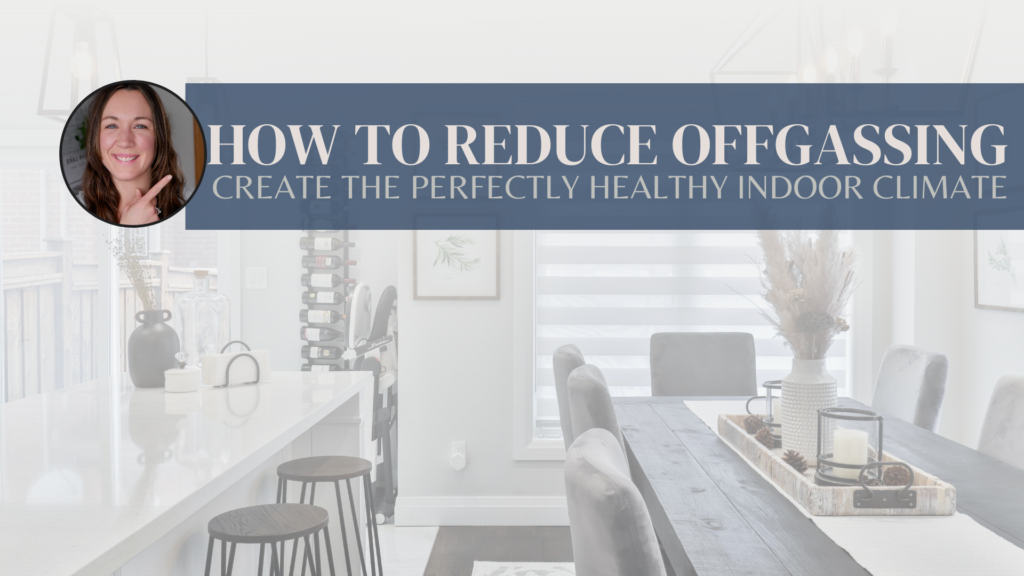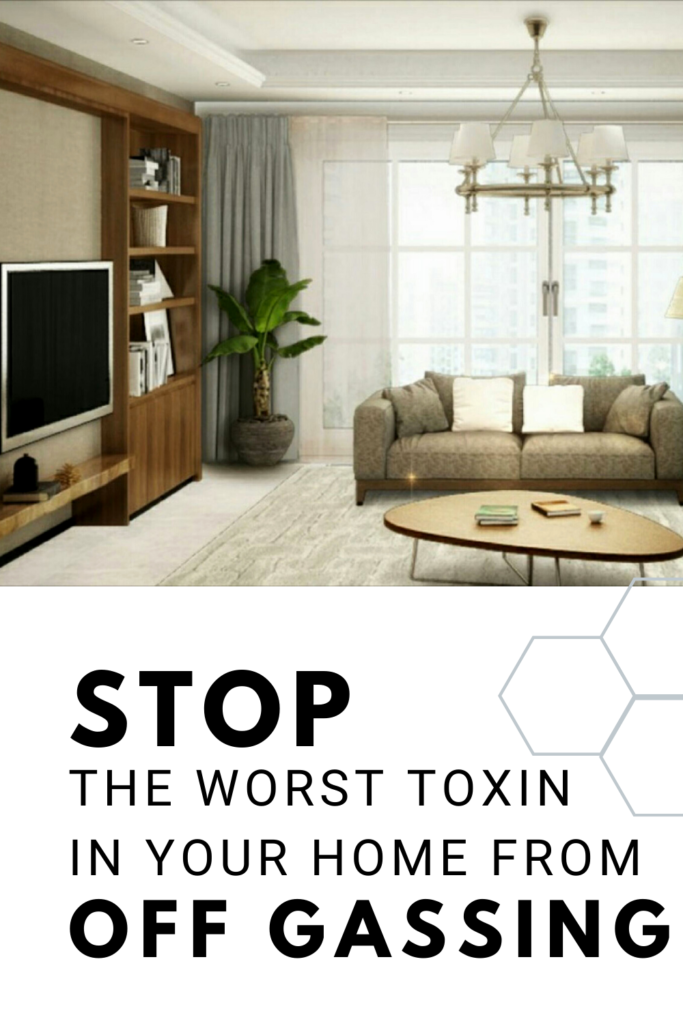
I’m sure you’ve heard of the term “off gassing” — but if you’re like I was, you may also not REALLY know what it means (or how it’s affecting our body and space in BIG ways). But I really think that once we understand a type of toxin or in this case, HOW a toxin gets into our home, the easier it becomes to reduce it overall.
I think maybe a little part of me never REALLY wants to know about a toxin – like I’m watching a suspenseful movie with one eye open — I want to know, but I don’t want to know all the awful side effects. Because I know that my home contains PLENTY of toxins, I know my kids and myself are certainly exposed to our fair share.
But then I have to remind myself that we do our best to limit the toxins we can, and while sometimes it doesn’t FEEL like that’s enough, it most certainly is doing a HUGE favor to our health and wellness.
And to be honest, if you don’t know about toxins or about chemicals that you COULD reduce in easy ways, you’ll miss a huge opportunity to create a healthier home.
This week’s post will take you through what off gassing is and how to actually create a climate at home that limits off-gassing from your current products and materials.

SO WHAT IS OFFGASSING?
Off-gassing is a process that occurs for years after a product is made, and it’s the release of chemicals in vapor form. Oftentimes you can detect strong off-gassing by the odor, but even when the fumes have gone away, there is still off-gassing going on, it’s just more subtle.
Essentially almost everything off-gasses — trees outside, plants, etc. But the real problem is that the off-gassing that happens indoors is obviously stronger, and the vapors have less space to go, and so the build up in concentrated levels.
While we’re all at risk of off-gassing exposure, kids and those with weakened immune systems are at the most risk for suffering symptoms of exposure. Short term exposure can cause headaches, respiratory irritation, sore throat, nosebleeds, and light-headedness. Long term exposure has been associated with respiratory illness, hormone disruption, damage to kidneys and liver, and increased risk of cancer.

MATERIALS IN YOUR HOME THAT OFF GAS THE MOST
You may have heard the notion that EVERYTHING in your home is off gassing — from plants to carpet. And while this is true, there are some products and materials that off-gas A LOT more than others.
Here are the big offenders:
Carpet: everything from the backing to the pad underneath the carpet to any adhesives used in the carpet or installation, they all produce VOCs. While some states have laws that are designed to reduce VOC emissions, there are most likely STILL plenty of toxins off gassing into your space.
Vinyl Flooring: Vinyl contains polyvinyl chloride, and any adhesives used with the flooring will contain formaldehyde, both of which will off-gas in the home. Vinyl flooring is one of the WORST materials to bring into your home and it’s often installed in bedrooms, living areas and so the sheer volume of the material becomes a problem as well.
Foam Mattress: Polyurethane foam and memory foam off-gasses a whole slew of VOCs, including toluene and formaldehyde. What’s so problematic with a mattress is that we are generally in the closest proximity to the mattress than to any other material in our home. AND we’re usually on the mattress for long periods of time, creating a disaster for our body and immune system as it works overtime.
Furniture & Upholstery: Pressed wood furniture is the biggest culprit here when it comes to VOCs. The small amounts of wood that are pressed together are usually held together by an adhesive that emits formaldehyde, a carcinogenic VOC. Upholstery can also contain formaldehyde in the fabric as well as PFOAs that are added to treat the textile fabric for water resistance and stain resistance.
Textiles & Curtains: Textiles such as pillows, blankets and curtains are often treated with chemical solutions to keep them from wrinkling and keep them resistant to stains and to water. These products are often in warm environments, which encourages them to off-gas at even higher rates than if they were in a cool and dry environment.
Cleaning Products: Many cleaning products contain fragrances to cover up the scent of harsh solvents and chemicals, both of which contain VOCs. Products will off gas when being used, but can also off-gas when being stored too. My Healthy Home Blueprint Online Course can help you facilitate a MAJOR ditch and switch in your home to swap out all your cleaning products.
WHAT TOXINS OFF GAS
Most of the time, VOCs are the type of toxin that we talk about off-gassing. VOCs, or volatile organic compounds are a type of toxin, and there are A LOT of specific VOCs that we are either exposed to in large quantities, or that are particularly dangerous to our health:
Formaldehyde: Carcinogenic, changes in lung function, skin rashes, eye irritation
Toluene: Inflammation of the skin, anxiety, muscle fatigue, liver and kidney damage, nerve damage, insomnia
Phthalates: Insulin resistance, allergies, asthma, overweight/obesity, hormone disruption, lower IQ, adverse effects on neurodevelopment,
Acetone: Sore throat, respiratory irritation, nausea, fast heart rate, confusion, damage to skin, headache.
Chemical Flame Retardants: neurological damage, hormone disruption, increased risk of cancer, body burden, thyroid disruption, reproductive problem,
Benzene: Skin and respiratory irritation, blood disorders, damage to the reproductive system, anemia, damage to the immune system, increased risk of cancer

CREATE AN ENVIRONMENT THAT LIMITS OFF GASSING
The type of environment that produces the MOST off gassing is one that is warm and humid. Humidity encourages products and materials to off gas at a much higher rate in comparison to a dry climate. Heat is another way that you can encourage off-gassing.
Essentially an environment with an ideal healthy house humidity level of 35% – 40%, is the BEST way to create conditions that discourage off gassing in your home. And rooms that get humid, like laundry rooms, bathrooms or kitchens, be sure to use a vented fan to pull moisture out of the room and expel it outdoors.
These are also spaces to be especially aware of toxic materials. If you can make sure humid rooms of your home have the fewest toxic products or materials, you’ll be able to limit off-gassing in the space when the humidity levels are high just due to normal use and human habits.
And while you don’t have to create a COLD home environment, limiting the amount of time your home is extremely warm can help reduce the amount of VOCs that are being off-gassed. This is especially true of your bedroom, which is where you likely spend a large portion of a 24 hour day.
And finally, get your home as much fresh air from outside as possible. The most important thing you can do for the health of your home is to practice natural ventilation as much as possible. This will allow those VOCs to escape outside while also diluting any toxins left inside to reduce the amount of concentration.

HEALTHY HOUSE PRACTICES TO HELP WITH CURRENT OFF GASSING
Floor Time: If you have conventional carpet or vinyl flooring, chances are the off-gassing levels are pretty high. The closer in proximity you are to the floor, or the closer your kids or babies are to the floor the higher risk of off-gassing exposure. While I think it’s near impossible to stop our kids, babies and toddlers from hanging out on the floor, there are some options here:
- Replace the flooring if possible
- Use a non-toxic rug on top of flooring to allow a barrier between your kids and the flooring
- Apply a VOC blocker to stop off-gassing like AFM VOC Blocker
Stop Purchasing Pressed Wood: While it might be a bit much to expect you to replace current furniture, you can make it your goal to stop purchasing pressed wood moving forward. Opt for solid wood furniture if you can help it. This might mean looking for older, used furniture or buying unfinished furniture or custom made furniture.
And then as you slowly replace furniture as it wears out or as your budget allows, use the same philosophy to purchase natural, solid wood furniture. Eventually you’ll get out a lot of sources of formaldehyde and other toxic VOCs.
Use a VOC Blocker: If you’ve got access to plywood in your home (maybe an unfinished floor or you’re in the middle of a home remodel project), you can certainly apply a VOC blocker to stop some of the off gassing that’s currently going on in your home. AFM Safecoat has one for pressed wood surfaces (areas that aren’t frequently touched) as well as one for finished surfaces like MDF trip, doors and furniture.
Don’t Use Harsh Chemicals: Anything that is intended to remove paint, varnish or even nail polish generally has some pretty harsh chemicals in it. Acetone is in many of these removers and brings a lot of negative health effects with it. Do your best to look for products that are low toxin if you need to dissolve or remove any sort of substance.

Let’s be honest, VOCs can sound like a scary thing when it comes to toxins inside your home. But I want you to remember that ANYTHING you can do to reduce them (even if it’s something small) will be a HUGE benefit to your health. Eventually you’ll get around to those big projects too in order to reduce VOCs, which will just give you more momentum . Sometimes you have to start small, and that’s 100% okay.




